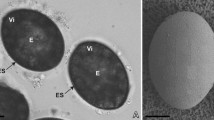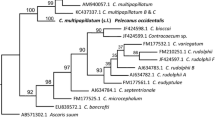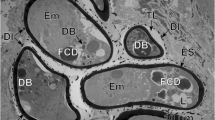Abstract
MORPHOGENETIC movements which occur during the early stages of animal embryogenesis are difficult to study unless some kind of marking technique is used. In vertebrates vital staining of small cell patches1 or application of charcoal powder2 has permitted the construction of maps showing extensive morphogenetic movements during early embryogenesis. Similar techniques have proved useful for the study of morphogenesis in other animal phyla. There are, however, no reports on successful intra vitam staining of insect eggs. This may be because the protective covers of most insect eggs do not permit dyes to enter locally, while eggs deprived of their covers cease to develop. Morphogenetic movements taking place during the plasmodial stages3 of insect embryogenesis therefore had to be reconstructed from a series of fixed material4–6 or were analysed by using local defects as markers7,8 and by time lapse studies7,9,10. Defect marking more than other techniques involves the danger of misinterpretation. Time lapse studies and investigations on fixed material share the disadvantage that only a limited range of structures located in the egg plasmodium can be traced satisfactorily, for example, nuclei or special inclusions of the cytoplasm; furthermore, work with fixed material is technically difficult and cinematography fails to reveal movements within bulky eggs sufficiently clearly. Renewed attempts to overcome these handicaps have produced a technique which, although far from being as versatile as vital staining in amphibians, serves to reveal the type and extent of movements within the whole egg plasmodium of the house cricket (Acheta domesticus L.) during germ band formation and anatrepsis.
Similar content being viewed by others

References
Vogt, W., Roux' Archiv Entw. Mech. Org., 106, 542 (1952).
Spratt, jun., N. T., J. Exp. Zool., 120, 109 (1952).
Krause, G., and Sander, K., Adv. Morphogen., 2, 259 (1962).
Seidler, B., Z. Morphol. Oekol. Tiere, 36, 677 (1940).
Rempel, J. G., and Church, N. S., Canad. J. Zool., 43, 915 (1965).
Schwalm, F., Z. Morphol. Oekol. Tiere, 55, 915 (1965).
Seidel, F., Roux' Arch. Entw. Mech. Org., 132, 671 (1935).
Mahr, E., Roux' Arch. Entw. Mech. Org., 152, 662 (1961).
Sauer, H. W., Z. Morphol. Oekol. Tiere, 56, 143 (1966).
Schanz, G., dissertation, Univ. Marburg (1966).
Ramamurty, P. S., Exp. Cell Res., 33, 601 (1964).
Beck, F., and Lloyd, J. B., J. Embr. Exp. Morphol., 11, 175 (1963).
Seidel, F., Zool. Anz. Suppl., 27, 121 (1964).
Sander, K., Zool. Anz. Suppl., 31 (in the press).
Author information
Authors and Affiliations
Rights and permissions
About this article
Cite this article
SANDER, K., VOLLMAR, H. Vital Staining of Insect Eggs by Incorporation of Trypan Blue. Nature 216, 174–175 (1967). https://doi.org/10.1038/216174a0
Received:
Issue Date:
DOI: https://doi.org/10.1038/216174a0
- Springer Nature Limited
This article is cited by
-
Blocked endocytotic uptake by the oocyte causes accumulation of vitellogenins in the haemolymph of the female-sterile mutants quitPX61 and stand stillPS34 of Drosophila
Cell & Tissue Research (1994)
-
Inhibition of yolk formation in locust oocytes by trypan blue and suramin
Roux's Archives of Developmental Biology (1987)
-
Das zeitliche und r�umliche Muster der Dottereinlagerung in die Oocyte von Apis mellifica
Zeitschrift f�r Zellforschung und Mikroskopische Anatomie (1973)
-
Fr�hembryonale Gestaltungsbewegungen im vitalgef�rbten Dotter-Entoplasma-System intakter und fragmentierter Eier vonAcheta domesticus L. (Orthopteroidea)
Wilhelm Roux' Archiv f�r Entwicklungsmechanik der Organismen (1972)
-
Die Einrollbewegung (Anatrepsis) des Keimstreifs im Ei vonAcheta domesticus (Orthopteroidea, Gryllidae)
Wilhelm Roux' Archiv f�r Entwicklungsmechanik der Organismen (1972)




